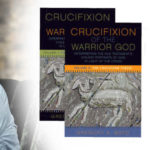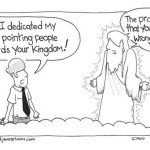We run our website the way we wished the whole internet worked: we provide high quality original content with no ads. We are funded solely by your direct support. Please consider supporting this project.
A Coming Storm
There is a storm beginning to brew on the horizon. It is a debate among Evangelicals about the violent depictions of God, stirred up largely by Eric Seibert’s Disturbing Divine Behavior. Here is a post that sounds “the clarion call.”
The debate is presently around two options.
Option #1: Traditionalists argue we must simply embrace the violent depictions of God in the OT (and the allegedly violent Jesus of the book of Revelation). The price we must pay to accept this option is that we must accept that genocide (e.g. Deut. 7:1-2; 20:16-20), ripping babies out of the womb of pregnant mothers (Hos. 13: 16), causing parents to cannibalize their children (Lev. 26:29; Jer. 19:9; Lam. 2:20; Ezek. 5:10), commanding parents to stone to death their children when they engage in certain behaviors or reflect certain attitudes (Ex. 21:15, 17; Lev. 20:9; Deut. 21:18-21), and a multitude of other similar atrocities can sometimes be considered just, holy and good, for God sometimes performs and commands such actions.
While I agree with these folks that all Scripture must be embraced as “God-breathed,” I also consider the price of accepting Option #1 to be too high. For one thing, I consider it a moral certainty that commanding people to mercilessly slaughter infants (and a number of other horrendous things attributed to God) is always wrong. Moreover, a wealth of research demonstrates that violent depictions of God in literature that people considered sacred is a powerful force in justifying and inciting religious violence, as the bloody history of the Church demonstrates all-too clearly. As one who is called to be a peacemaker (Mt. 5:9), I consider it imperative we end the precedent this material sets by denouncing it. Yet, the most important reason I consider this price too high is that these violent depictions of God contradict the revelation of God in the crucified Christ, which is the definitive revelation that trumps all others, as I shall argue at length in my forthcoming book, The Crucifixion of the Warrior God.
Option #2: Certain progressive Evangelicals such as my friend Eric Seibert and the Nazarene OT scholar C.S. Cowles argue that we must reject these violent depictions of God. In Disturbing Divine Behavior, for example, Eric appeals to skeptical OT scholarship that suggests that the OT’s conquest narrative is not anchored in history, so we need not accept its genocidal portrait of God. The price we must pay to accept this option is that we must accept that it is permissible to at times dismiss canonical material.
While I fully empathize with Eric’s concern over Scriptures’ violent material and applaud the bold manner in which he identifies the problem, I also regard the price this option requires us to pay to be too high. On the authority of Jesus, the entire NT and the church tradition, I feel compelled to embrace all Scripture, including its violent depictions of God, as divinely inspired, and I take this to mean we never have the right to dismiss any part of it. Moreover, as I demonstrate in The Crucifixion of the Warrior God, if we’re going to try to solve the problem of divine violence in the OT by rejecting these portraits, we’re going to end up dismissing a great deal of Scripture. Like it or not, the fact of the matter is that the basic storyline of the OT is woven around horrifically violent depictions of God (e.g. the Flood, the Passover, the Conquest of Canaan, the overthrow of the Northern and Southern kingdoms). Remove the violence of the OT and it’s not clear that anything like a coherent narrative remains.
My forthcoming book introduces a third option into this debate. I find it highly significant that, before the Church got comfortable with the use of violence, and even for a while afterwards, there were a number of noteworthy theologians who did not see these as the only two options. Thinkers like Gregory of Nyssa, John Cassian and especially Origen felt compelled to embrace all canonical material as divinely inspired and thus considered it impossible to dismiss. Yet, largely because of the revelation of the enemy-loving, non-violent God in Christ, they also felt compelled to reject a literal interpretation of the OT’s violent depictions of God. They therefore embraced this violent material, but they did so while reinterpreting it.
Unfortunately, once the Church accepted the use of violence in the fourth and fifth centuries, Scripture’s violent depictions of God not only ceased being problematic, they became advantageous inasmuch as these portraits provided a precedent that could be appealed to for Church authorities to incite Christians to engage in violence – despite Jesus’ emphatic instructions to the contrary (e.g. Mt. 5: 38-48; Lk.6:27-35). The reinterpretation project was thus unfortunately aborted.
This is the option I want to resurrect and defend in The Crucifixion of the Warrior God. Yet, while I believe these early church theologians were pointing us in the right direction, I do not think the allegorical way these theologians reinterpreted this material is plausible any longer. I am rather proposing what I call “The Cruciform Thesis.” It consists of four principles that I derive from the revelation of God on the cross, for I argue that the cross is the quintessential revelation of God and the thematic center of everything Jesus was about. (For a sampling of my argument, go here.)
It’s interesting that Church theologians throughout history have been very willing to reinterpret large portions of Scripture that were considered problematic for one reason or another. For example, consider how much Scripture must be reinterpreted to get Scripture to conform to the classical conception of God as atemporal, immutable and impassible! While I don’t accept this conception of God, my project is standing in line with this long theological tradition. It’s just that, instead of reinterpreting Scripture to get it to align with the metaphysical attributes of God, I’m reinterpreting it to get it to align with the moral attributes of God. More specifically, I’m attempting to interpret it in a way that allows us to see how even the most horrific portraits of God are not only consistent with, but actually bear witness to, the enemy-loving, non-violent, self-sacrificial character of God revealed in the crucified Christ.
I believe my thesis will appeal to people to the degree that they find both of the options that are thus far present in the debate to be unacceptable as well as to the degree that people accept that the revelation of God in Christ isn’t one revelation alongside others, but is rather the definitive revelation that trumps all that preceded him. It will be interesting to see how this all pans out.
Stay tuned! And, most importantly, pray that God pours out his Spirit on all involved in this debate to empower us to conduct it in a spirit of Christ-like love, grace and humility.
Ryan Heaney via Compfight
Category: Essays
Tags: Bible, Cruciform Theology, Debate, Essay, Evangelism, Jesus, OT Violence
Topics: Interpreting Violent Pictures and Troubling Behaviors
Related Reading

Podcast: Would a Loving God Create a Box that Killed Anyone Who Touched It?
Greg discusses the Ark of the Covenant and it’s strange and violent nature. http://traffic.libsyn.com/askgregboyd/Episode_0266.mp3

Sermon Clip: Through Samaria
In this final installment of the Women on the Outside series, we explore the story of the woman at the well Jesus encountered while traveling through Samaria and how he dives right in to the gender and racial tensions of the first century Jewish culture. You can listen/watch the full sermon here: http://whchurch.org/sermons-media/sermon/through-samaria

The Cross in the Manger, Part 2
While some shepherds were tending their flock, an angel appeared to them announcing “good news that will cause great joy for all the people,” for it news about “a Savior…the Messiah, the Lord” (Lk 2:10-11). Most Jews of this time expected a Messiah who would save them by vanquishing their Roman oppressors and liberating Israel…

Podcast: What is Crucifixion of the Warrior God?
In this 100th episode Greg gives us a peek at Crucifixion of the Warrior God. Pre-order your copy of the book here: The Crucifixion of the Warrior God: Volumes 1 & 2 (Fortress Press, 2017) http://traffic.libsyn.com/askgregboyd/Episode_0100.mp3

Imaging God Rightly: God’s Self-Portrait, Part 3
In the previous two blogs I noted that the vision of God in our minds is the single most important vision in our lives, for it completely determines whether we’ll have a relationship with God and what kind of relationship this will be. A. W. Tozer once wrote, “What comes into our minds when we…


